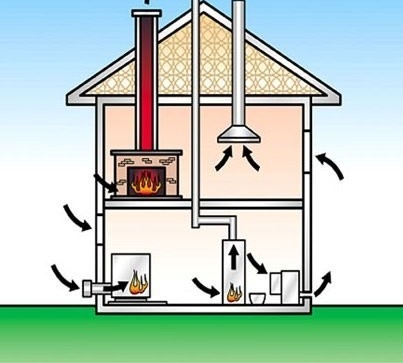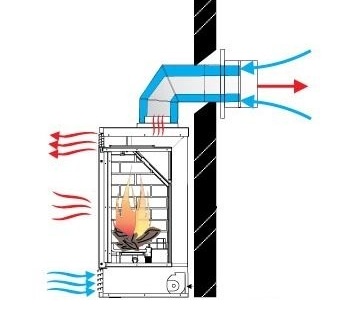Chimney connection to a floor gas boiler: internal and external pipe outlet
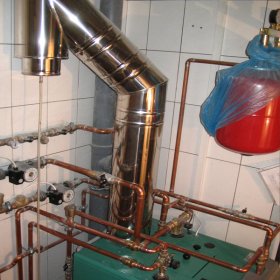
In a gas boiler, as in any other heating device that works with fire, gases are released during the combustion of fuel. In their chemical composition, they are very dangerous for humans. Therefore, a properly equipped chimney for a gas boiler can be considered a necessary condition for its safe use. We will consider the main aspects of the correct installation of the smoke exhaust channel and see what requirements are imposed on this process.
Content
The list of requirements for the chimney for the boiler
To exhaust the exhaust gases and supply the boiler with the air necessary for the combustion process, special equipment is used. Outwardly, it is most often represented in the form of a shaft, inside of which a pipe is installed.
The design must meet a number of requirements:
- Installation of the chimney is carried out strictly in an upright position. It is not permissible to have extensions or constrictions inside the flue duct.
- The device is made only of non-consumable and non-combustible materials.
- The structure should not have cracks or other mechanical damage through which the combustion products can enter the room.
- When assembling the structure, only high-quality heat-resistant sealants are used.
- The diameter and height of the pipe must correspond to the output parameters of the boiler, otherwise it will be impossible to achieve enough traction.
We suggest you watch a video with an analysis of the main errors when choosing a chimney for a boiler:
Topic article: Norms and requirements for the chimney for a gas boiler - what is important to know during installation?
Smoke exhaust system
For proper connection, you need to get acquainted with the device of standard chimneys for gas boilers. The design includes several basic elements:
- a gas duct through which the boiler is connected to a flue system;
- fragments of an attached structure;
- the inspection hatch located at the bottom of the pipe, which is designed to inspect and clean the chimney;
- brackets for attaching the device to the wall.
During installation, additional elements may be needed: bends, tees and clamps. If fragments of the structure are inserted one into the other, clamps are not needed. During the design and installation process, you must strictly adhere to the requirement not to equip more than three turns of the smoke exhaust channel.
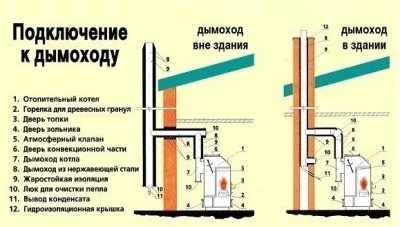
The chimney for the gas boiler can be arranged inside the building or outside (click to enlarge). For each of the options, standard connection schemes have been developed, which should be followed during installation
The chimney for a gas boiler can be external or internal. There are standard connection schemes for both the first and second.In accordance with them, the installation is performed. If you have to choose a non-standard option, it must necessarily comply with all standards. In any connection scheme, the horizontal section of the chimney must have a bias towards the boiler of at least 3 ° per meter.
The installation and subsequent connection of the gas boiler to the chimney is best entrusted to specialists. Errors in its arrangement are fraught with serious problems in subsequent operation. If the work is done independently, the following factors must be taken into account:
- Connection of several heating devices to one chimney by combining pipes is unacceptable. Otherwise, the combustion products will fall into the room.
- It is forbidden to connect elements from galvanized pipes and bricks, asbestos and aluminum.
- Work should only be carried out after preliminary calculations have been carried out in order to ensure that the dimensions of the chimney correspond to the parameters of the gas boiler.
- The standard chimney height is at least five meters.
- When mounted on a flat roof, the device must rise at least 1.5 m above it.
- The height of the pipe, whose axis is located at a distance of 1-3 m from the roof, is determined by the level of the ridge.
- The chimney, rising above the ridge by more than 2 m, must be additionally fixed with special building extensions.
It should also be noted that the installation process for external and internal structures is somewhat different. We suggest you study the difference between them using an example of a steel chimney installation.
Option # 1 - installation of a chimney indoors
We start with the markup. We outline the holes for the smoke channel in the roof and ceilings. Carefully check the markup and size of the passage pipe. Only after that we cut out the holes. Next, we begin the installation. We connect the adapter to the branch pipe extending from the boiler. We install the revision and tee, fix the steel sheet and mount the main bracket. Now you can expand the pipe to the desired size. If it is provided by the project, we use knees.
We very carefully carry out transitions through overlappings. To comply with safety requirements, we use a special pipe for these purposes. We put on a sheet of galvanized steel with a cut out hole on the flue channel, which is slightly larger than the diameter of the pipe. Securely fasten the sheet on both sides to the overlap. Joints are necessarily reinforced with clamps, tightened with bolts or wire. We fix the exhaust pipe every 2 m with wall clamps and every 4 m with brackets.
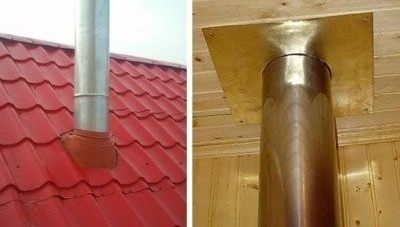
The section of the passage through the roof must be equipped extremely competently! Be sure to isolate places where the chimney is in contact with flammable materials
All areas where the elements of the chimney are in contact with easily flammable materials of the building must be properly insulated. We cover the passage pipe from all sides with a special foil basalt mat and coat it with refractory mastic. In the overlap around the perimeter of the opening, we lay mineral wool insulation. After the installation is completed, we check the tightness of the structure. We put the usual soap solution on the joints of the structure and connect the boiler. If bubbles appear, it means that combustion products go through the seams and you need to seal them again.
We offer you to watch a video example of installing a chimney indoors:
Option # 2 - chimney outlet outside the building
Mark the area of the outlet of the chimney out. Carefully verify the dimensions of the pipe and the markings, after which we make a hole. To the pipe of the gas boiler we connect a passage element and bring the chimney to the street. For the transition we use a special pipe. We well isolate the hole in the wall and the pipe fragment passing through it. We fix the tee with the audit, put on the cap.
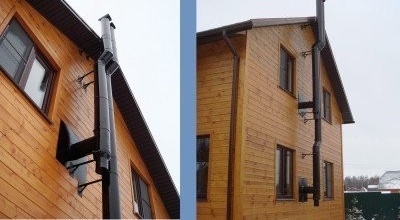
The external chimney must be firmly fixed to the wall of the building with special brackets, which are located no more than 2 m from each other
We begin to build up the pipe, adding new links to it. The structure is securely fastened to the wall every 2 meters at least. We reinforce the joints with clamps, which we tighten with bolts or wire. We gain the required height of the chimney and finish the work by installing a cone-shaped tip. If the discharge channel is running from sandwich pipes, insulation is not required; if not, then we begin insulation work. At the end, you can paint the structure with heat-resistant paint to protect it from corrosion.
The installation features described above are typical for floor heating appliances. Chimneys for wall-mounted gas boilers are best done from double-circuit pipes. Coaxial Chimney consists of two elements, one of which is inside the other. Its main advantage is that gases are discharged through one of the pipes, and air enters the boiler through the other. Such systems increase the efficiency of the gas boiler and make its use safer. Mounting the device is quite simple. The passage pipe is installed on the pipe from the boiler and is brought out.
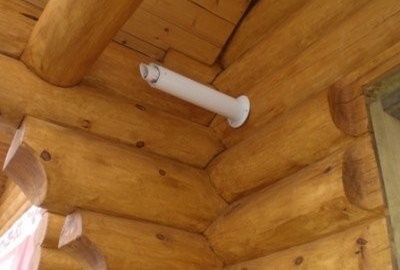
For wall-mounted gas boilers, experts recommend the use of coaxial designs that not only guarantee safe operation, but also increase the efficiency of the heater
Gas-fired heating appliances initially carry a potential danger to others. All work associated with the installation of such equipment and its connection must be performed accurately and competently. It is best for specialists who have undergone special training to do this, then the operation of the gas boiler will be completely safe.
